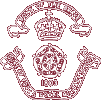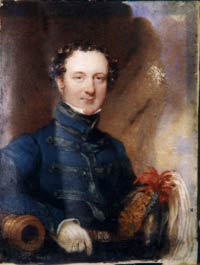


 |
 |
|
 |
||
| Navigation links at the bottom of this page | ||||
| Captain W. Siborne, Adjutant of the RMA (1843-1849) | ||||
| Captain William Siborne (1797-1852) can with certainty be identified as the last casualty of the Battle of Waterloo. True as this statement is, Siborne was never wounded in battle, nor was he on the field of Waterloo on that fateful day, 18 July 1815. Not until 15 years after the Duke of Wellington, later Lord Wellington, with Prussian help, had won the day. Siborne's misfortune lay in his brilliance as a topographer, investigator, and researcher. Ultimately, his scholarship led to revealing Wellington, by then Commander in Chief of the Army, in a sin of omission, which sealed the Siborne's fate as surely as the hangman's noose makes a kicking swinger of a man condemned to die at the gallows. | ||||
| 'Born in Greenwich, Kent, in 1797, William Siborne had the conventional upbringing as the son of a gentleman of modest means. His father, who held a commission in a militia unit, transferred to a regular regiment of the line during the Napoleonic Wars. Siborne junior gained admission to the Royal Military College (1), graduated in 1814, and joined the 9th Foot (The Norfolk Regiment) with a commission. Although he missed the action at Waterloo, his unit formed part of the Army of Occupation in France where he remained until 1817. That year, like thousands of other officers, he was put on half-pay. By 1826, however, he secured a full time post as Assistant Military Secretary to the C-in-C of Ireland at Kilmainham, near Dublin. | Captain William Siborne © Peter Hofschröer.
|
 |
||
|
Lieutenant Siborne established a reputation as an expert topographer over the
next few years [his first book, Instructions for Civil and Military Surveyors
in Topographical Plan-drawing, dedicated to Lord Hill, was published in
1822, so his reputation was established before the Dublin posting] and became
a strong advocate of the use of models of battles as a training tool for officers.
A fellow officer described him as "...a most able officer. A man of fine
intellect and judgement...and very well informed." Siborne's diorama of
the Battle of Borodino helped consolidate his reputation and bring him to the
attention of the War Office. In 1830, he was offered a commission to create
a model of the Battle of Waterloo, which was to be the main exhibit of the
new United Services Museum (2) and
a memorial to Wellington's crowning victory.
Siborne undertook the commission with alacrity and on an understanding that the War Office would fund the project. To his lasting regret, that understanding was not given in writing. Nevertheless, he put his heart and soul into the enterprise and, at his own expense, spent the next eight months on the battlefield of Waterloo making meticulous notes and sketches of the topography. [The WO refunded his expenses up to and including 1833, but cut off funding then, forcing Siborne to raise his own funds]. He also interviewed survivors on all sides of the last great conflict of the French wars: veterans of the French, German, British and Dutch armies. The resulting work, first exhibited in 1838, should have brought Siborne public distinction and wealth. Instead, it brought him Wellington's implacable hostility and the lasting enmity of the military commander's admirers and subordinate general officers. Opposition was not universal. There were those – many who kept their heads below the parapets – who supported the lowly lieutenant's findings, for he would otherwise not have been appointed Adjutant (3) of the RMA. Wellington wrote his Waterloo Despatch the day after the battle. It appeared in The Times four days later, on 22 June 1815. Acknowledging the 'timely assistance' of the Prussians, Wellington, put their arrival on the field of battle at 7 p. m. The evidence, from Siborne's extensive research and correspondence with numerous survivors from all armies, including official despatches and records, timed the arrival of the Marshall Blucher's army at 4.30 p.m. a considerable difference in timing indeed. Nor was the 4.30 p.m. arrival of Prussian reinforcements of a trivial order. They arrived in force and attacked the French enemy in force at the hinge of the battle between Napoleon's and Wellington's opposing armies. At the start of the day, Wellington had 68,000 troops all arms against Napoleon's 72,000. By late afternoon, both sides were exhausted. The arrival of 48,000 Prussians in force spelled the difference between a stalemate and victory. In short, the Prussians came in overwhelming numbers at a crucial time that put the enemy firmly to rout. |
||||
Intent on portraying the
state of affairs at the moment of victory, Siborne set the time of his
diorama of the battle at 7:15 p.m. It went on display in 1838 and showed
the true position of the combatants with 48,000 Prussian troops actively
engaged. The finished model measured 24 feet by 19 and included over
90,000 hand-painted lead soldiers. Siborne's model was a magnificent
achievement, but he reckoned without the extreme displeasure of Wellington
and his sycophantic supporters. This was bad news for Siborne, who suffered
immensely for his honesty of purpose. Siborne's reputation did not end at his death, but has been questioned
again and again by legions of military historians. Even so, he was not
entirely without his supporters who, though not as strong and influential
as those who ruined him, he did receive some protection. What is more,
some of those who helped him were in positions of influence. He got his
appointment (4) [He purchased
his captaincy in 1840. See: PRO WO76/186 fol 29] to the post of Adjutant
of the Royal Military Asylum, Chelsea, occurred in 1843 (five years after
the row with those in authority at the War Office erupted), when he
replaced Captain J. Ludgard who had been with the Asylum since it opened
its doors in 1803. Ludgard died in office, having held the post for the
past forty years. On the other hand, he was subjected by the powers that be in the War Office to injustice and a profound dismissal of his legitimate expenses. In addition to his diorama of the battle, he also published a History of the War in France in 1815, based on his research. This was republished in a U.S.A. edition in 1845 and a German edition in 1846, which would have brought him additional income. On the other hand, his work was plagiarized without mercy by none other than the Rev. G. R. Gleig (6), which led to litigation. Indeed, Siborne truly suffered the 'slings and arrows of outrageous fortune' during his life time and long after, more recently by one David Hamilton-Williams (7) who accuses his son Major-General Herbert Siborne of doctoring the Waterloo Letters and warping the account to make those officers who supported his father look good. The accusation of course is patently untrue. One may have no doubt that he edited the correspondence, but any idiot with the slightest knowledge of publishing knows that correspondence to be published must be edited. Planning his research, Siborne had sent a copy of his plan to Lord Wellington for approval. Wellington told his close advisor, presumably Lord Fitzroy Somerset that he did not know "the position of each body of the troops under my command, much less of the Prussian Army (8)." The Horse Guards invited Siborne to explain his numbers (regarding the disposition and numbers of the Prussian Army), advising that Lord Fitzroy Somerset wished to discuss "some points which are very material to the perfect accuracy of your plan, especially touching the share the Prussians actually had in deciding the battle (9). Similarly, in the same correspondence, the War Office warned Siborne to "Keep the object of your journey quiet but," wrote the correspondent "believe me you will do well to come." In conducting his research, Siborne had contacted the armies of the various German states; the Prussian General Staff; the French Ministry of War; and obtained a copy of the Prince of Orange's papers. Not surprisingly, Siborne refused to bend to the will of the War Office and refused to attend the pleasure of Fitzroy Somerset. Five years after the first public appearance of the diorama (the year he was appointed Adjutant of the RMA), Siborne, removed the figures representing 40,000 Prussian soldiers from the model. It was a gesture on his part to pacify, appease and mollify Wellington in the hope that the War Office would release to funds to pay off his debts. Official silence greeted Siborne’s gesture. Unlike Chamberlain in 1938, he even lacked a piece of paper to wave in mock victory over his enemies. Captain Siborne, one-time Adjutant of the RMA, has been vindicated and history must condemn Wellington for his monstrous ego and his failure to share his victory with his Prussian allies, but more roundly for exercising his immense influence to demean a gallant and scholarly junior officer, hounding him to an early grave. See Wellington on Waterloo for further discussion of the subject. |
||||
|
||||
| ||||||||||
|
© A. W. Cockerill 2011 Site Map Contact me | ||||||||||